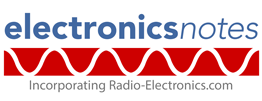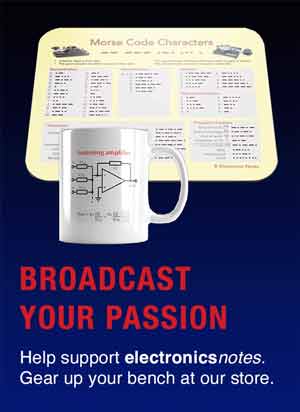Home » Component data » Diode (PN junction) data » this page
ES1D PN Junction Diode Data
Key data for the ES1D fast recovery semiconductor diode including key electrical parameters, performance, features, outline, package type and many other key datasheet details.
The ES1A is an SMD fast recovery diode intended for a variety of power applications, especially in various forms of switching power supplies where fast switching speed is required.
It is part of the ES1 series of diodes which have maximum reverse voltages between 50V (ES1A) to 1000V (ES1M). The ES1D has a sufficiently high reverse voltage for many applications, making it very popular.
Key details and performance parameters for the ES1D diode.
| ES1D diode datasheet parameters & data |
|
|---|---|
| Parameters | Details |
| Diode type | Surface mount superfast rectifier |
| Package type | DO214 (also known as SMA 403) |
| Repetitive peak reverse voltage, VRRM | 200V |
| Working peak reverse voltage, VRWM | 200V |
| DC blocking voltage, VR | 200V |
| RMS reverse voltage, VR(RMS) | 35V |
| Forward continuous current, IF | 1A |
| Non-repetitive forward surge current, IFSM | 30A half sine wave 8.3ms |
| Maximum reverse current IR | 5.0µA at 25°C and 100µA at 100°C at rated voltage |
| Maximum power dissipation | 1.47 W |
| Junction temperature (°C) | -50 - +150°C |
| Forward voltage VF | 0.92V @ 1A |
| Diode junction capacitance CD | 7.0pF |
| Reverse recovery time (Trr) | 15ns |
Outline & pinout:
Explanation of major diode parameters
| Parameter | Explanation |
|---|---|
| Repetitive peak reverse voltage, VRRM | This is the maximum value of the short period peak reverse voltage that can be sustained. |
| Working peak reverse voltage, VRWM | This is the maximum value of the continuous reverse voltage that can be applied to the diode. |
| DC blocking voltage, VR | This is the maximum reverse DC voltage that should be applied across the diode. |
| RMS reverse voltage, VR(RMS) | As many AC waveforms are quoted in RMS, this is the maximum reverse voltage that can be sustained where the voltage is expressed in terms of its RMS value. |
| Forward continuous current, IF | This is the maximum forward current that can be sustained by the diode. |
| Average rectified current, IF | This is the maximum average current value that can be handled by the diode. The parameter often states the load as this will affect the operation of the diode. |
| Non-repetitive forward surge current, IFSM | This is the maximum surge current that can be handled - it should only be present for a short time. |
| Parameter | Explanation |
|---|---|
| Power dissipation, PTOT | The maximum power dissipation that can be sustained within the device. |
| Junction temperature (°C) | This is the maximum temperature of the PN junction that can be sustained. Remember that the junction temperature can be much higher than the ambient temperature of the equipment. |
| Forward voltage VF | This parameter gives the forward voltage drop for a particular current passed through the diode. |
| Breakdown voltage VBR | This is the minimum voltage at which the diode may breakdown. If the current is not limited it will lead to the destruction of the device. |
| Leakage current IR | This is the current that flows under stated conditions when the diode is reverse biassed. |
| Diode capacitance CD | The diode capacitance, CD may also be referred to as the junction capacitance, CJ. All diodes have a certain capacitance across the PN junction. The value will be stated for a given reverse voltage. |
| Reverse recovery time | If a diode is initially driven in forward bias, and the polarity suddenly switches to reverse bias, the diode will still remain conducting for some time. The reverse recovery time is the time required for conduction to settle into the reverse bias state. |
These are the main diode parameters that have been included in our list. There are others, but these help quantify the main elements of the performance of the diode.
Please note, that the data given is the best estimate we can give within a tabulated summary of this nature. Parameters also vary between manufacturers. Electronics Notes cannot accept any responsibility for errors, inaccuracies, etc, although we do endevaour to ensure the data is as accurate as possible.
Notes and supplementary information
• Availability & sources
The ES1D is available from a number of stockists and electronic component distributors many of which are given in the table below.
ES1D Component Distributor, Stock and Pricing
• Notable features
The ES1D is a surface-mount ultra‑fast (or super‑fast) recovery rectifier diode optimized for high-frequency switching and compact PCB use.
Rated reverse voltage : Up to 200 V repetitive peak reverse voltage (VRRM)
Average forward current : 1 A continuous in typical usage
Fast recovery / reverse recovery time : Typically ~ 15 ns (some datasheet variants up to ~ 25–35 ns)
Forward voltage drop : ~ 0.92 to 0.95 V at 1 A
Surge current capability : 30 A non‑repetitive (single half-cycle) surge current (IFSM)
Low leakage current : ~ 5 µA at reverse voltage (typical)
Compact SMD package : DO‑214AC (SMA) for surface mount, low profile
Glass‑passivated junction : for stability and reliability under temperature cycling and bias stress
Wide temperature range : −55 °C to +150 °C junction operating range
Pick & place convenience and strain relief : designed for automated assembly with built‑in mechanical robustness
RoHS / environmental compliance : offered in lead‑free, halogen‑free “green” versions in many variants
• Typical applications summary
| Application Category | Typical Use Case | Device Feature Utilised |
|---|---|---|
| Switch‑Mode Power Supplies (SMPS) | Output rectification or secondary-side return diode in high-frequency DC–DC converters | Fast recovery reduces switching losses; moderate forward drop |
| DC-DC Converters / Regulators | Catch / freewheeling diode in boost, buck, or flyback topologies | Ability to switch quickly and handle surge currents |
| Inductive Load Suppression | Flyback diode across coils, relays, or motors to clamp reverse spikes | Fast recovery and surge current tolerance |
| Polarity / Reverse Protection | Blocking reverse voltage in compact power paths | Low leakage in reverse and low forward drop in conduction |
| General Fast Rectification | High-frequency AC to DC rectification in compact circuits | High switching speed and appropriate voltage rating |
| Power Supply / Power Management Modules | Fast switching paths, reverse recovery diodes in multi‑phase modules | Fast recovery and compact form factor useful in dense assemblies |
Fast recovery diodes are specifically designed to handle rapid switching conditions, making them ideal for use in switch-mode power supplies (SMPS).
In these applications, power devices operate at high frequencies—often in the tens or hundreds of kilohertz—which means that any delay in diode switching can result in increased power loss, heat generation, and reduced overall efficiency. Fast recovery diodes significantly reduce reverse recovery time (trr), which is the interval required for the diode to stop conducting after the polarity of voltage across it reverses.
By minimizing this delay, fast recovery diodes reduce switching losses and electromagnetic interference (EMI), both of which are critical to achieving high efficiency and reliable operation in SMPS.
Another advantage is that fast recovery diodes typically have lower stored charge during conduction compared to standard rectifiers. This not only speeds up their turn-off behavior but also limits the amount of reverse current that must be absorbed by the switching transistor during each cycle. This reduces stress on other components in the power conversion path, leading to improved thermal performance and greater durability of the overall circuit.
In high-frequency SMPS designs—like those used in computers, industrial power units, and LED drivers—fast recovery diodes help enable compact designs, higher power density, and better thermal management.
• Diodes in ES1 Series
| Part Number | VRRM (Maximum Repetitive Peak Reverse Voltage) | VRMS (Maximum RMS Voltage) |
|---|---|---|
| ES1A | 50 V | 35 V |
| ES1B | 100 V | 70 V |
| ES1C | 150 V | 105 V |
| ES1D | 200 V | 140 V |
| ES1E | 300 V | 210 V |
| ES1G | 400 V | 280 V |
| ES1J | 600 V | 420 V |
| ES1K | 800 V | 560 V |
| ES1M | 1000 V | 700 V |
 Written by Ian Poole .
Written by Ian Poole .
Experienced electronics engineer and author.
Return to Component Data menu . . .




